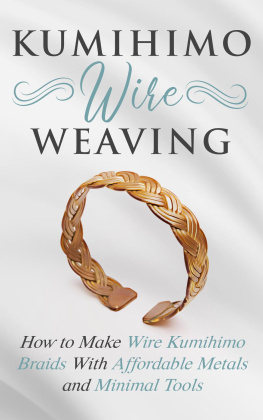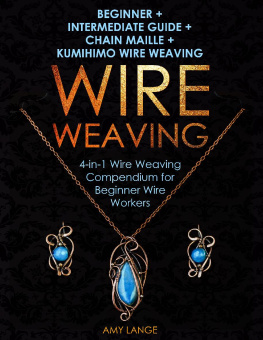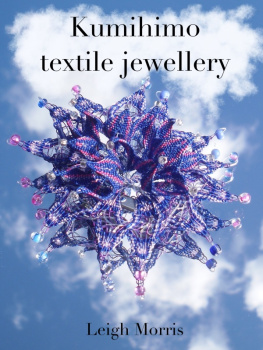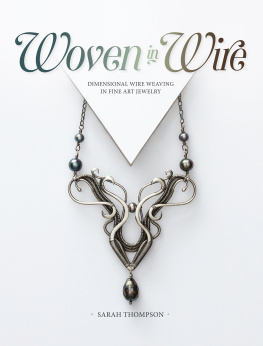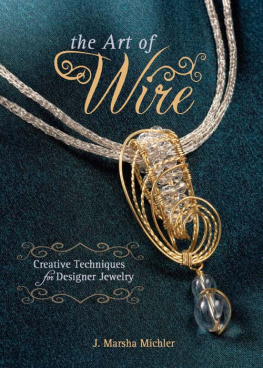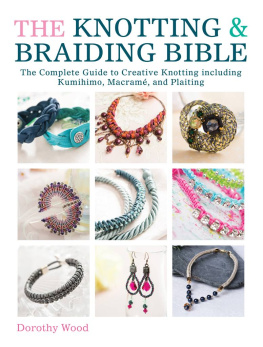Kumihimo Wire Weaving
How to Make Kumihimo Braids With Affordable Metals and Minimal Tools
Copyright 2019 - All rights reserved.
The content contained within this book may not be reproduced, duplicated or transmitted without direct written permission from the author or the publisher.
Under no circumstances will any blame or legal responsibility be held against the publisher, or author, for any damages, reparation, or monetary loss due to the information contained within this book, either directly or indirectly.
Legal Notice:
This book is copyright protected. It is only for personal use. You cannot amend, distribute, sell, use, quote or paraphrase any part, or the content within this book, without the consent of the author or publisher.
Disclaimer Notice:
Please note the information contained within this document is for educational and entertainment purposes only. All effort has been executed to present accurate, up to date, reliable, complete information. No warranties of any kind are declared or implied. Readers acknowledge that the author is not engaging in the rendering of legal, financial, medical or professional advice. The content within this book has been derived from various sources. Please consult a licensed professional before attempting any techniques outlined in this book.
By reading this document, the reader agrees that under no circumstances is the author responsible for any losses, direct or indirect, that are incurred as a result of the use of information contained within this document, including, but not limited to, errors, omissions, or inaccuracies.
Table of Contents
K umihimo refers to a type of Japanese method of braiding by which different kinds of stringing materials are used. Often beads are also used to make unique jewelry and home decor items. The meaning of the word Kumihimo is to gather threads. In this technique, a variety of looms are used to make different kinds of braids. There is a vast scope for creativity and countless designs can be made using simple tools.
You can give a new look to your object by using different numbers and colors of strands. The type of stringing materials used can also give an entirely novel look to the piece. Moreover, the beauty of the object can be enhanced by adding beads, magatamas, and cabochons.
You can even use different kinds of wires to make jewelry using Kumihimo techniques. Although there are people who spend a lot of money and buy gold and silver wires for this purpose, you can make items using inexpensive wires, too. You will be surprised to see that even with a simple copper wire you can make exquisite items.
If you are interested in this craft but you are hesitant to take it up because you think it may involve an excessive expenditure, you can throw caution to the wind. This hobby can be pursued using simple tools and inexpensive materials. This book will help you to learn the basics of Kumihimo wire braiding.
If you are a Kumihimo braider and want to start doing projects with wire, then this book will be very useful for you. You will learn how to make various Kumihimo designs with wire. Lets get started!
Chapter 1: Tools Required for Making Wire Kumihimo
T he basic things required for wire Kumihimo are as follows:
Kumihimo Disks Made of Foam
T hese disks are not expensive and you can easily write on them if you want to mark anything. They are portable and lightweight.
They are available in square and round shapes. Square disks are used for making flat braids. They are suitable for making flat bracelets. The round disks are usually in 4-inch and 6-inch sizes. They are used to make round braids that have a hollow central core.
W hen making kumihimo braids, you need to manage a number of strands of wire. Plastic bobbins are useful for this purpose. They are also helpful in holding the beads in the right place while braiding.
These bobbins are inexpensive. They are available in most of the local craft shops. You can also buy a set of these bobbins online from a bead supplier.
EZ-Bob Kumihimo bobbins - They are handy small plastic disks that keep the wires from tangling. You can unfold their cover and wind the wire onto them, and then fold the cover back. In this way you can manage the wires easily. Small ones are a little less than two inches in diameter. Large ones are 2.5 inches in diameter. You can get eight small bobbins for around $3.25, and eight large ones for around $3.75.
Y ou can buy fine-gauge copper wire for your project. The 24 and 26 gauge wire is finer than the 12 gauge wire. So choose the thickness of the wire depending on the type of object you are planning to make. For example, if you wish to make a piece of jewelry it is better to use a 24 or 26 gauge wire while a 12 gauge wire is more suitable for making home decor items. In the beginning you should use 26 gauge soft copper wire for your Kumihimo project.
Zebra wire - Zebra wire is a 30 gauge fine wire used for Kumihimo braiding. It is a copper wire with a beautiful color coating. It has a glossy finish and is strong and flexible. It is available in spools of 50 yards. Each spool costs around $3.95.
Next page
